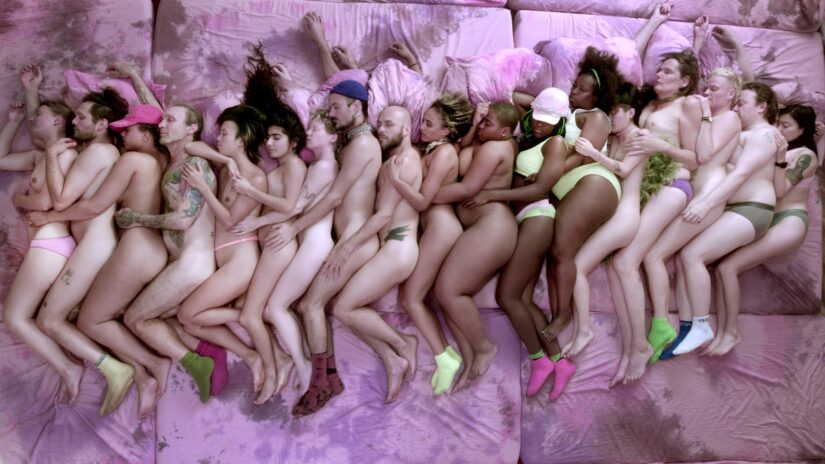Anisha Baid, melanie bonajo, Dora Garcia, Milda Januševičiūtė, Amanda Hunt, Maja Kalafatić in Tina Jeranko, Tatiana Kocmur in collaboration with Ivana Kocmur, Eva Mulej Vrabič, and Liza Šimenc, Marko Marković, Iva Suhadolnik Gregorin, Sonja Vulpes
12. September, 8 pm, Račka Gallery
Amanda Hunt, Maja Kalafatić and Tina Jeranko: Will Someone Help Me Bathe This Body, performance
In a time of resisting our own bodies – when we do not allow them to age or become ill – in Western culture, we are quick to assess ourselves through self-presentation, while increasingly attributing responsibility for our mental state to individual choices and lifestyle.
The problem is that this is how the economic, political, and social demands under which bodies operate are being excluded. In this context, the increase in panic attacks, anxiety, depression, isolation and other mental health issues can be understood as a form of body language that responds to and expresses itself in the face of oppressive social forces, particularly when the mind attempts to suppress feelings and sensations through rationalisation. The body records everything, even when the mind seeks to escape. Psychotherapist Alice Miller has described in her study how hiding the power of violence, or turning it against oneself, has a devastating effect on the body. The exhibition entitled Body Resist, which extends across two venues – the Likovni salon Gallery and Račka Gallery – is based on an understanding of the body’s response to various negative stimuli and emphasizes that the body is in constant interaction with its environment, serving as a fundamental source of information and valuable knowledge. It points to the body’s power to resist at a moment when the mind is unable to do so.
The presented artworks address social antagonisms through bodily experience, shedding light on efforts to control and constrain the body, while also emphasizing a holistic perspective and rejecting universality, individualism, and rationality. In order to protect bodies from exhaustion they demystify success as a value and encourage slowing down. They emphasise the importance of diversity, exploring how to connect with the body, grow through pain and vulnerability, and restore closeness through consensual touch, care, attention and love.
In her work The Breathing Lesson (2001), artist Dora Garcia examines the ways in which the body becomes obedient. The piece shows a young girl practicing breathing exercises. The protagonist submits to the commands of her teacher, who controls her breathing rhythm by clapping her hands. During the performance, breath – a metaphor for freedom – is controlled, restricted and temporarily prevented from being expressed. The exploration of the limits of the body interests the artist Marko Marković, who in his performance Southeast Sadness in Central Europe (2021) consumes flowers, to which the body reacts violently with resistance, with nausea. Among other things, the artist draws attention to the toxicity of consumer culture, which poisons bodies. Artist Milda Januševičiūtė addresses the relationship to autoimmune disease. In her work hope this finds you well (2018), she highlights the relationship between the mind and the body, as well as the concept of false hope and belief. She turns to non-Western principles of healing, which focus on holistic treatment of the individual rather than on the symptoms of a disease. Through the process of grieving, as a way of coming to terms with an illness, she builds a narrative in which scientific research intertwines with the poetic and the intimate. Similarly, Tatiana Kocmur is concerned with how pain reshapes the body, especially in cases where it has experienced acts of sexual violence. The work Flesh (2024), co-created with Ivana Kocmur, Eva Mulej Vrabič, and Liza Šimenc, uses performative rituals to explore how trauma can be processed through the renewed process of accepting and loving one’s own body. In the exhibition, the artist presents a new version of the work and invites visitors to participate.
The performance Will Someone Help Me Bathe This Body (2024) focuses on the question of care in a temporary community, among queer friends and/or colleagues. Inspired by the figure of a woman who carefully washed the backs of others in Finnish saunas, artists Amanda Hunt, Maja Kalafatić and Tina Jeranko go beyond the traditional perception of intimacy. Through the performance of several hours of bathing, the artists emphasize the bare body as a bond of a temporary community, where tenderness and platonic intimacy take centre stage – without shame or sexual connotations. Similarly, melanie bonajo explores the intimacy of a temporary queer community in their video When the body says Yes! (2022), which seeks ways to connect with others through awareness of their own bodies. We follow the rituals and gestures unfolding within a colourful design of the set and costumes, where touch becomes the central tool for communication on sexuality beyond the Western discourse. In her performance piece I am not in this world to work (2022), Iva Suhadolnik Gregorin exposes her naked body to address the need to slow down as an act of resisting the capitalist demands of constant productivity. Instead of hyperproduction, the artist chooses to withdraw from work and take a rest. The intertwining of work and leisure is depicted in Anisha Baid’s photo series Laptop Yoga (2025). In her photo performance, the artist draws on stock photographs found online, further highlighting the absurdity of combining relaxation with the simultaneous physical contortions of the body. Relaxation that she might have achieved through yoga never fully surfaces, as it is always conditioned by the posture of working at a computer. A slightly different take on one’s own image of the self can be found in Sonja Vulpes’s series Cake (2025), in which the artist depicts personal mental states through childhood memories of birthday parties. The image of the cake becomes an extension of the artist’s body, embedding the pleasure symbolized by the cake into her self-portrait. Playful images illustrate the bodily experience through which the artist explores self-love.
Curators: Irena Borić, Maja Hodošček
Supported by: Ministrstvo za kulturo RS, Mestna občina Celje

